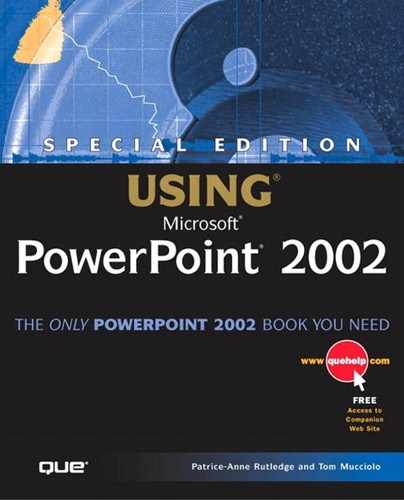Using Action Settings
Use the Action Settings dialog box to start an action by clicking an object with the mouse or simply by passing the mouse pointer over it.
For example, you can place an object, such as a rectangle, in your presentation and have it connect to the Web, play a sound, run a macro, or open another program when you click it or pass the mouse over it. This can be useful when you want to demonstrate other applications during your presentation, but don't want to take the time to try to locate and open them in the middle of a slideshow.
To add an action to a PowerPoint object, follow these steps:
Select the object to which you want to add an action.
Choose Slide Show, Action Settings to open the Action Settings dialog box, shown in Figure 15.12.
Figure 15.12. Use a mouse click or mouse over to perform actions in your presentation.

Choose the Mouse Click tab if you want to start the action with a mouse click; choose the Mouse Over tab to start the action by passing the mouse over the object. The Mouse Click and Mouse Over tabs are nearly identical. The only real difference is the method by which you start the action.
Caution
Passing the mouse over an object to start an action is the easier method, but be careful not to get too close to the object too soon or you might start the action before you intend to.
PowerPoint provides five main action choices in this dialog box, as well as the capability to activate a sound. Choose one of the following:
None No action occurs. Choose this option to remove a previously placed action.
Hyperlink To Creates a hyperlink to a selected slide within your presentation, another PowerPoint presentation, another file on your computer, or a Web page.
→ For further explanation about using hyperlinks in PowerPoint, see “Adding Hyperlinks” in Chapter 16, “Using PowerPoint's Web Features.”
Run Program Runs the program whose path you specify in the text box. You can click the Browse button to open the Select Program to Run dialog box, where you can search for the appropriate program.
Tip from
You can also use Run Program to open a file in another program. For example, entering c: budget.xls would open Excel and the Budget worksheet.
Run Macro Lets you choose from a list of PowerPoint macros you've created.
→ To learn how to create macros, see “Running a Macro from the Toolbar” in Chapter 20, “Working with PowerPoint Macros.”
Object Action Enables you to open, edit, or play an embedded object. This option is available only for objects that you can open, edit, or play, such as a media clip or an organization chart.
Play Sound Enables you to play a sound you select from the drop-down list. You can select other sounds by choosing Other Sound from the drop-down list.
Highlight Click/Highlight when Mouse Over Highlights the selected object when you perform the mouse action.
Click OK to close the Action Settings dialog box.
Are your animation effects not working when using PowerPoint 2000? See the “Troubleshooting” section near the end of the chapter.
